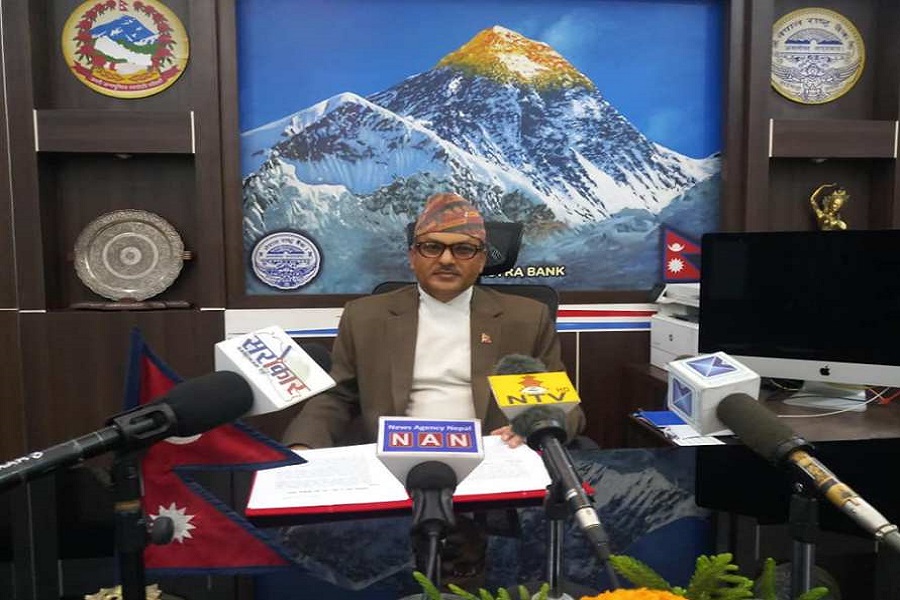KATHMANDU: In a significant shift from its initially stringent regulations, Nepal Rastra Bank (NRB) has embraced a more flexible monetary policy, as revealed in its first quarterly review for the fiscal year 2023-24. Despite the challenges posed by achieving the inflation target within the current fiscal year, the central bank has opted for a more adaptable approach.
While the monetary policy for the last fiscal year aimed to maintain the policy interest rate above the target inflation limit, the inflation target for the current fiscal year has been set at 6.5 percent. The policy rate, initially set at 6.5 percent, has been reduced to 5.5 percent in the first quarter. Additionally, the bank rate has been lowered from 7.5 percent to 7 percent, and the deposit collection rate has seen a reduction from 4.5 percent to 3.0 percent. This marks a clear shift towards a more flexible monetary policy, with indications that interest rates may decrease further in the future.
Dr. Gunakar Bhatt, the spokesperson of the central bank, noted that the monetary policy’s focus has returned to addressing inflation concerns. “Considering other economic indicators, current economic activity, and the economy’s needs, the central bank has prioritized these aspects,” he stated. The move aligns with the goal of fostering sustainable economic activities.
President of Nepal Bankers Association, Sunil KC, anticipates a further decrease in interest rates following the central bank’s reduction in the policy rate. He believes this will assist businesses facing cash flow issues and increased costs.
The central bank has also introduced measures to ease loans for shares and real estate, responding to the private sector’s demand for greater flexibility. Real estate loans and shareholding loans above Rs 5 million now carry reduced risk weight, dropping from 150 percent to 125 percent. Monthly installment income ratios for housing loans up to Rs 5 million have been increased to 60 percent, facilitating easier access to small loans for homebuyers.
Former executive director of Nepal Rastra Bank, Nara Bahadur Thapa, sees the monetary policy review as aligning with national goals. However, he critiques the central bank for contributing to economic volatility in recent years, particularly in the stock and real estate markets. Thapa suggests that the central bank’s handling of policy stability has been inconsistent, leading to a cycle of boom and bust in the economy.
While the central bank acknowledges the potential risks to the external sector and trade deficit, it asserts the necessity of a flexible monetary policy to accommodate stakeholders and influential groups in the economy. Despite facilitating borrowers in financial distress, the central bank remains firm on enforcing consequences for intentional loan defaults, emphasizing the need for a balanced approach.
The International Monetary Fund (IMF) has recommended setting the policy rate based on inflation data, a practice also adopted by the central bank. However, despite an inflation rate of 7.5 percent, the policy rate has been reduced to 5.5 percent, leading to criticism from observers like Thapa, who expressed concerns about the central bank’s ability to handle pressure and maintain professionalism.
Some high-ranking officials within the central bank argue that external pressures from the private sector, influenced by government actions, have caused the central bank to deviate from its mandated responsibility of ensuring price stability.
The central bank acknowledges potential risks, such as an increase in the trade deficit and pressure on the external sector, as evidenced by past trends in earthquake reconstruction, domestic production, and trade balances. Adopting a flexible monetary policy is deemed necessary in response to these challenges. The central bank is seen as working to facilitate stakeholders and influential groups in the economy who are taking proactive initiatives.
In terms of loan defaults, the central bank aims to assist borrowers facing financial challenges while maintaining a strict stance against deliberate non-payment of loans. The monetary policy review outlines plans to enhance the effectiveness of actions taken against borrowers intentionally avoiding loan repayments. Simultaneously, borrowers facing genuine financial difficulties will be supported through mechanisms such as loan restructuring and rescheduling.
To achieve this, the central bank indicates that banks and financial institutions will have until the end of April 2024 to restructure loans, with the condition of collecting 10 percent of the outstanding interest. The eligible areas for restructuring will be expanded, providing more flexibility in addressing financial challenges.
Furthermore, the central bank is set to facilitate microfinance borrowers who maintain regular contact but struggle to regularize their loans due to circumstances. Arrangements will be made to restructure the loans of such borrowers if they submit applications for loan restructuring to the institution by April 2024.

